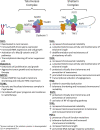Non-canonical roles of canonical telomere binding proteins in cancers
- PMID: 33599797
- PMCID: PMC8164586
- DOI: 10.1007/s00018-021-03783-0
Non-canonical roles of canonical telomere binding proteins in cancers
Abstract
Reactivation of telomerase is a major hallmark observed in 90% of all cancers. Yet paradoxically, enhanced telomerase activity does not correlate with telomere length and cancers often possess short telomeres; suggestive of supplementary non-canonical roles that telomerase might play in the development of cancer. Moreover, studies have shown that aberrant expression of shelterin proteins coupled with their release from shortening telomeres can further promote cancer by mechanisms independent of their telomeric role. While targeting telomerase activity appears to be an attractive therapeutic option, this approach has failed in clinical trials due to undesirable cytotoxic effects on stem cells. To circumvent this concern, an alternative strategy could be to target the molecules involved in the non-canonical functions of telomeric proteins. In this review, we will focus on emerging evidence that has demonstrated the non-canonical roles of telomeric proteins and their impact on tumorigenesis. Furthermore, we aim to address current knowledge gaps in telomeric protein functions and propose future research approaches that can be undertaken to achieve this.
Keywords: Cancer; Shelterin; TERT; Telomerase; Telomere.
Conflict of interest statement
The authors declare that they have no conflict of interest.
Figures
Similar articles
-
Acute telomerase components depletion triggers oxidative stress as an early event previous to telomeric shortening.Redox Biol. 2018 Apr;14:398-408. doi: 10.1016/j.redox.2017.10.004. Epub 2017 Oct 7. Redox Biol. 2018. PMID: 29055871 Free PMC article.
-
Telomeres and telomerase: three decades of progress.Nat Rev Genet. 2019 May;20(5):299-309. doi: 10.1038/s41576-019-0099-1. Nat Rev Genet. 2019. PMID: 30760854 Review.
-
Telomere shortening and loss of self-renewal in dyskeratosis congenita induced pluripotent stem cells.Nature. 2011 May 22;474(7351):399-402. doi: 10.1038/nature10084. Nature. 2011. PMID: 21602826 Free PMC article.
-
Dyskeratosis congenita: the diverse clinical presentation of mutations in the telomerase complex.Biochimie. 2008 Jan;90(1):122-30. doi: 10.1016/j.biochi.2007.07.017. Epub 2007 Jul 31. Biochimie. 2008. PMID: 17825470 Review.
-
Dyskeratosis congenita, stem cells and telomeres.Biochim Biophys Acta. 2009 Apr;1792(4):371-9. doi: 10.1016/j.bbadis.2009.01.010. Epub 2009 Feb 7. Biochim Biophys Acta. 2009. PMID: 19419704 Free PMC article. Review.
Cited by
-
The Role of Telomerase in Breast Cancer's Response to Therapy.Int J Mol Sci. 2022 Oct 25;23(21):12844. doi: 10.3390/ijms232112844. Int J Mol Sci. 2022. PMID: 36361634 Free PMC article. Review.
-
Combatting cellular immortality in cancers by targeting the shelterin protein complex.Biol Direct. 2024 Nov 22;19(1):120. doi: 10.1186/s13062-024-00552-4. Biol Direct. 2024. PMID: 39578854 Free PMC article.
-
Telomeres expand sphere of influence: emerging molecular impact of telomeres in non-telomeric functions.Trends Genet. 2023 Jan;39(1):59-73. doi: 10.1016/j.tig.2022.10.002. Epub 2022 Nov 17. Trends Genet. 2023. PMID: 36404192 Free PMC article. Review.
-
Telomere Reprogramming and Cellular Metabolism: Is There a Link?Int J Mol Sci. 2024 Sep 29;25(19):10500. doi: 10.3390/ijms251910500. Int J Mol Sci. 2024. PMID: 39408829 Free PMC article. Review.
-
Identification of mechanism of cancer-cell-specific reactivation of hTERT offers therapeutic opportunities for blocking telomerase specifically in human colorectal cancer.Nucleic Acids Res. 2023 Jan 11;51(1):1-16. doi: 10.1093/nar/gkac479. Nucleic Acids Res. 2023. PMID: 35697349 Free PMC article.
References
Publication types
MeSH terms
Substances
Grants and funding
LinkOut - more resources
Full Text Sources
Other Literature Sources
Medical


